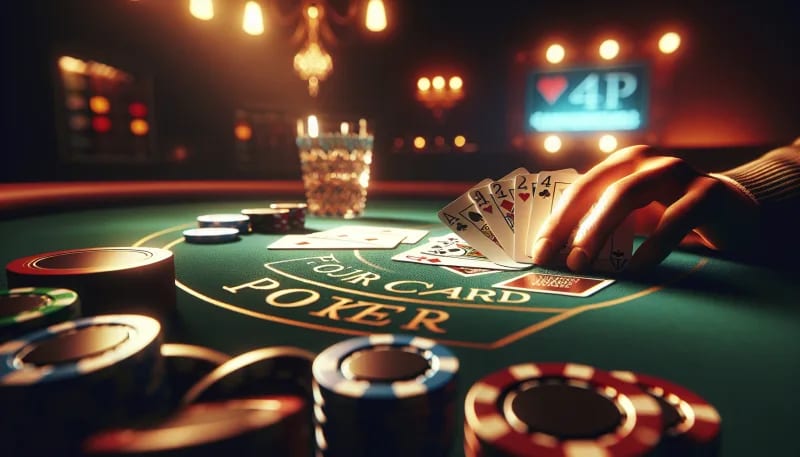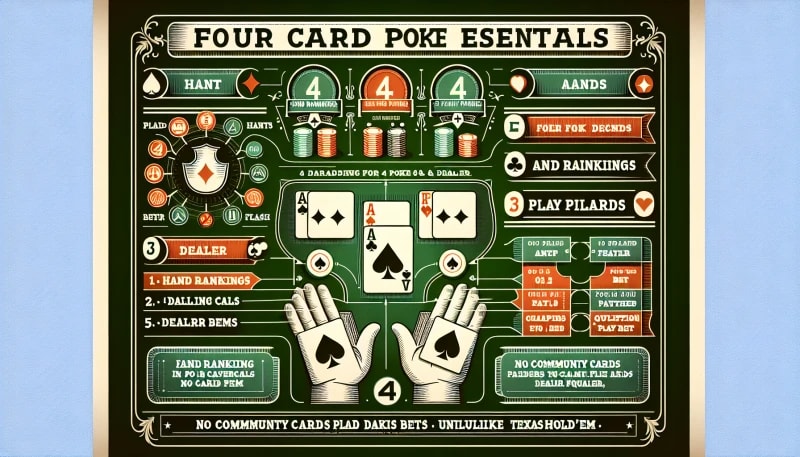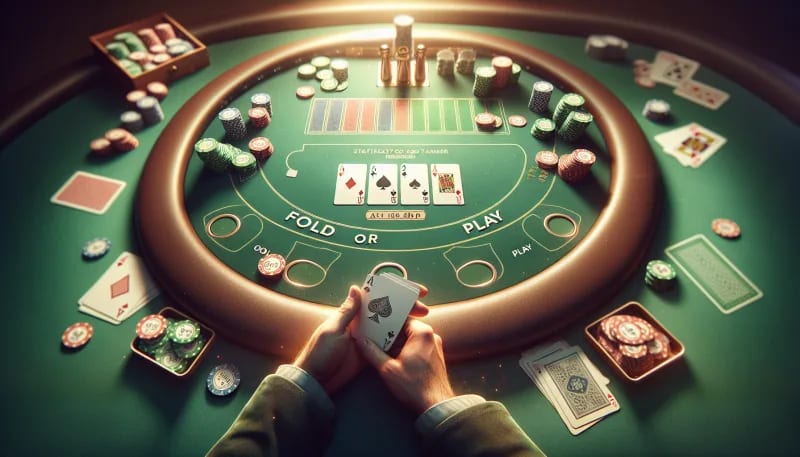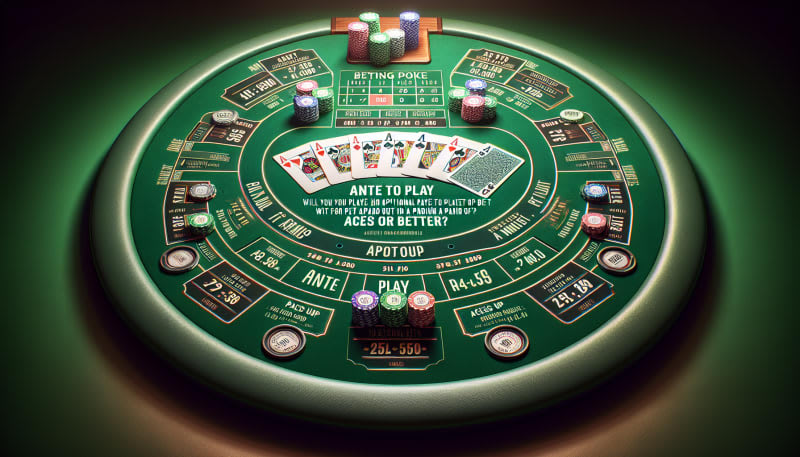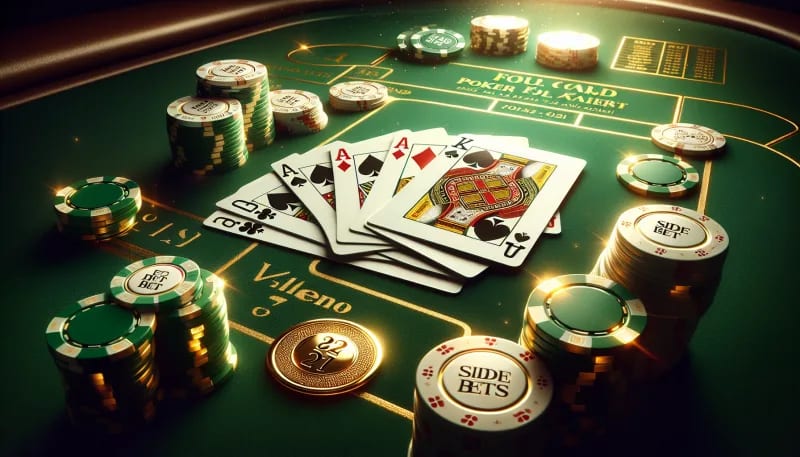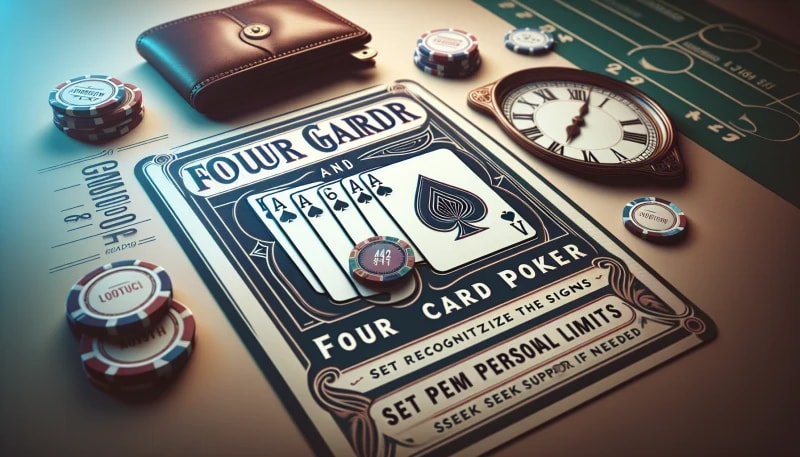Four Card Poker Guide: Rules & Beginner Strategies
Introduction to Four Card Poker
Have you ever stumbled upon a poker game that's not quite like the classic Texas Hold'em or Omaha? That's where Four Card Poker enters the scene. It's a relatively new kid on the block, having been invented by Roger Snow of Shuffle Master in the early 2000s. Despite its youth, it's quickly claimed a spot at the poker table, intriguing novices and seasoned players alike.
Why the rapid rise in popularity? Simplicity and pace. The game is easy to learn, making it welcoming for newcomers, and its fast nature keeps everyone on their toes. Unlike traditional poker games that can drag on, Four Card Poker deals you in and out in mere minutes. It makes for an energetic and sometimes breathless experience.
We can't overlook the allure of something fresh. Traditional poker variants are timeless, no doubt, but the fresh spin Four Card Poker offers has spiced things up. It's like ordering your favorite burger but discovering a new, zesty sauce that redefines the meal.
This game has confidently claimed its spot in both brick-and-mortar casinos and the digital realm. Whether you're walking the plush carpets of Vegas establishments or clicking through an online casino lobby, you're likely to encounter Four Card Poker. It's this ubiquitous presence that has allowed the game to flourish and become a staple alongside its five-card cousins.
Do you feel the buzz of potential and the itch to learn more? Are you ready to dive into a game that's both easy to pick up and effortlessly entertaining? Perfect, because as we transition into the next section, we'll delve into the Basic Rules of Four Card Poker. Understanding the rules is your first step to mastering this modern poker variant. So, get ready to shuffle up and deal. The tables await!
Basic Rules of Four Card Poker
Following our dive into Four Card Poker's introduction, let's unpack the rules. Unlike traditional poker, you're facing off against the dealer, not other players. Sounds intriguing, doesn't it?
First things first, hand rankings. They're slightly different here. At the pinnacle is the Four of a Kind, a powerhouse in this game. Next are the Straight Flush and then the Three of a Kind. It's important to note, pairs and full houses don't carry the same weight as in Texas Hold'em. Surprised? I was too.
Every game begins with an Ante bet. Feeling confident? Place an Aces Up bet too—it pays out when you hit a pair of aces or better, regardless of the dealer's hand.
Once bets are down, you're dealt five cards. But here's the twist: you must discard one to create the strongest four-card hand possible. Decision-making is critical.
Now, do you match your Ante with a Play bet or fold? It's a pivotal moment. If you play, your hand locks horns with the dealer's best four out of five cards. They need at least a King high to qualify.
Comparing Four Card Poker to its cousin, Three Card Poker, the extra card spices up strategies. And unlike Texas Hold'em, there's no community pool to pull from. Adds to the excitement, right?
One more thing - bonus payouts. They're lucrative for premium hands. So, even if the dealer outplays you, a prime hand could still mean a win.
And that's how you dance with the dealer in Four Card Poker. Ready to level up your gameplay? Let's stride into the next section with confidence: Strategies for Beginners. Stick with me, and I'll guide you through some foolproof tactics to build your game.
Strategies for Beginners
Building on the Basic Rules of Four Card Poker you've just grasped, let's ramp up your game. Remember, poker isn't just a game of chance; it's a strategic battlefield.
Firstly, hand selection—this is crucial. Do you hold cards worth playing? A high pair or better is your green light. Anything less? Proceed with caution. You don't need to play every hand, trust me.
When should you fold, then? If it looks like your cards are weak and the chances slim, folding saves your chips. Think defense. And it's not admitting defeat; it's playing smart.
Now, what about the dealer's hand? It can be a thorn in your side. But remember, they need at least a King-high to qualify. No qualifying hand from the dealer? That's your chance to capitalize.
Consider position. The closer to the dealer you are, the earlier you must act. This means less information. Tough, right? Acting later means more power, so use it wisely when you have it.
And rake? It affects your long-term bankroll. Consider its impact before sitting down at a table.
Some quick-fire advice? Be observant. Track patterns. Use them. Don't let emotions rule your decisions. It's tempting, but stay rational.
Remember, folding is not always a sigh of defeat. Sometimes it’s the whisper of a strategic retreat.
Lastly, remember, transitioning to Advanced Tactics for Seasoned Players needs a solid foundation. Build that here. Begin with strong basics, and the sky's the limit.
Advanced Tactics for Seasoned Players
Building on the basic strategies, let's dive into the nitty-gritty. You've got the hand rankings down. But how do you elevate your game from there? It's all about the finesse of a well-timed bluff, the acumen to read the dealer, and a deep understanding of odds and probabilities in Four Card Poker.
Bluffing isn't just about keeping a poker face. It's a calculated risk, a psychological game. Ask yourself: What's your table image? Are you seen as a tight player? Or do you call and raise like a maverick? Your image dictates how successful a bluff might be. Occasionally, showing a bluff can set a precedent, making future bluffs more believable. It's a long game strategy.
Reading the dealer, however, is about picking up subtleties. Observation is key. How do they handle their cards when they have a strong hand? Are there tells? Maybe they check their hole cards more often or there's a slight change in body language. Slight, but not imperceptible—not to an eagle-eyed player like you.
Now, odds and probabilities aren't to be glossed over. In Four Card Poker, understanding the likelihood of making certain hands is crucial. Realize that straights happen more often than flushes, unlike in Texas Hold'em. This knowledge should seep into your bones, influencing every wager, fold, and tactical fold.
Consider probabilities like an ally whispering secrets—the secret is always in the numbers. Chart out chances, familiarize yourself with the odds of making each hand—you've got to love the math to master the game, right?
And don't forget about implied odds, the expected value of a bet. It's not just about the current pot; it's about what you could potentially win. Are you leveraging this concept when the stakes are high?
Transitioning to 'Understanding the Betting Structure', you'll need these advanced tactics to truly excel. They form the bridge between knowing how to play and playing to win. See, it's not just about the cards you're dealt, it's about how you play them. Every move counts. Ready to raise the stakes?
Understanding the Betting Structure
Stepping up from advanced tactics, let's demystify the betting structure of Four Card Poker. It's crucial, right? You need to know how and when to bet to make the most of your hands.
First off, there's the Ante bet. You make this bet before you're dealt your hand. It's the cost of entry, the first step to getting into the action. Remember, the Ante bet must happen before any cards are seen.
Next, we talk about the Play bet. Once you've seen your cards, you decide if you want to up the ante - literally. If you like what you see, you place a Play bet, which can be up to three times your Ante bet. Here's where your strategic play jumps in. Bet sizing is key. How confident are you in your hand? Make sure your bet reflects that.
Then, there's the exciting Aces Up side bet. It's a separate wager that you can win regardless of what the dealer has. It pays out if you get a pair of aces or better. Think of it like a bonus game within the game, with its own potential for winning. The payouts vary but hitting a strong hand here can really boost your stack.
Are your bets thoughtfully made? You bet they are! You're sizing your bets not just on the strength of your hand, but also on the dealer's tendencies and the overall context of the game.
Heading into the next section, keep in mind that these bets all contribute to the house edge. Different bets offer different odds. Understanding them is key to framing your overall strategy. Let's delve into that next, shall we? We'll talk about the house edge and how it affects the odds in your favor — or against it.
House Edge and Player Odds
Transitioning from Understanding the Betting Structure, let's now delve into the house edge and how it impacts your chances at the felt. What exactly is the house edge? It's the mathematically calculated advantage the casino holds over players in a game. In Four Card Poker, this edge varies based on the game's setup and your play strategy.
The typical house edge in Four Card Poker hovers around 2-3%. Seems small, right? But over time, it can significantly diminish your bankroll. So how do we combat this invisible foe and boost our odds?
Play smart. Keeping a close eye on the pay tables is crucial. They dictate the house edge. Opt for games with the best payouts — your bankroll will thank you.
Know when to fold'em. Unlike other poker variants, in Four Card Poker, you're only up against the dealer—not other players. This simplifies your strategy. Fold with a hand lower than a pair, and raise with anything better.
Aces Up. Here's where it gets interesting. Placing the Aces Up bet can be tempting, offering high payouts for strong hands. But remember, while it adds excitement, it also increases the house edge. So, should you steer clear? Not necessarily, but proceed with caution and a clear strategy.
Every hand counts. With each decision, you're either tilting the scales in favor of the house or nudging them towards your corner. Stay disciplined, remain patient, and you increase your chances to come out on top.
As we wrap up here, ponder this: Are you ready to challenge the house edge? Keep these tips in your arsenal, and you just might.
Up next, let's take the 'leap of faith' to Four Card Poker Variants and Side Bets. More opportunities? More thrill? Let's find out together.
Four Card Poker Variants and Side Bets
So, you've got the house edge and player odds down, huh? What's next? Broadening the horizon with Four Card Poker variants and side bets, of course. But beware, as these can be a double-edged sword.
Four Card Poker is a bit of a titan in the casino world. It's like the standard three-card poker, but guess what? That extra card can change everything. Variants like Crazy 4 Poker and Four Card Prime shake things up, offering new ways to win and extra excitement. I mean, who doesn't like a fresh twist on a classic?
Now, let’s talk about the spice of table games: side bets. The Aces Up bet is a popular one. You're betting that your hand will have a pair of aces or better. It's quite straightforward and can lead to pretty decent payouts. But don't forget, the high reward comes with high risk.
Ever heard of The Prime side bet? It rewards you if all your cards are the same color. The more cards that match, the bigger the payout. It makes every card flip a little more thrilling. Plus, having a whole hand of one color just looks cool, doesn't it?
Excitement skyrockets with these side bets, but so does the risk. Every added wager chips away at your odds. It's a delicate dance of risk and reward that you should enter with eyes wide open.
Remember, the thrill of winning a side bet can be exhilarating, but it's important to weigh each risk carefully. Want to keep enjoying Four Card Poker without the stress of overstepping? It's essential to pivot towards Responsible Gambling and Four Card Poker. Identify the balance, and you'll preserve both the fun of the game and the health of your wallet.
Responsible Gambling and Four Card Poker
Following our dive into the exciting world of Four Card Poker variants and side bets, it's crucial we touch upon a topic that's often sidelined – responsible gambling. It's easy to get caught up in the thrill, but I can't stress enough the importance of playing responsibly.
How often do you find yourself chasing losses, or betting more than intended? It's a common trap, especially when variations and side bets offer tempting payouts. Let's talk about setting limits. Before I sit down at a poker table, I decide on a budget. This isn't just smart; it's non-negotiable. Decide on an amount you're comfortable with. And stick to it, no matter what.
Recognizing problem gambling behaviors is equally important. Do you play longer than planned? Does your gambling affect your relationships or work? These are red flags. If you're nodding along, it might be time to reconsider your approach to the game.
Remember, help is never far away. If you or someone you know struggles with gambling, there are resources available. Organizations like Gamblers Anonymous or the National Council on Problem Gambling provide not just help, but a community of support.
So, always keep in mind: Four Card Poker is a game. It's meant to be enjoyable, not detrimental. Play wisely, play responsibly. And if you ever feel the tables are turning against you, don't hesitate to reach out for help. Because gambling should never be a high-stakes gamble with your well-being.
In the world of poker—and life—knowing when to hold, fold, and seek assistance is the mark of a truly skilled player.
And with those parting thoughts on responsible gaming, I'll leave you with the invitation to continue unwinding the layers of strategy and fun that Four Card Poker offers. There is no next part, but your journey in mastering the game responsibly is an ongoing endeavor. Enjoy the game, but don’t forget to play—and live—wisely.

